Many dacities suffer from the fact that on the site the subspeted waters are too high. Excessive soil moisture is suitable not all plants, many develop badly or dying. You can solve the problem by making high beds. With such an organization of landings, it is possible to control the degree of moisture. A pleasant bonus to such a decision will be an earlier time of ripening and a much greater crop.
Advantages and disadvantages
In addition to solving problems with religion, high beds on the garden allow you to search or disembark the plants of the week 2-3 earlier: raised above the ground they warmer more actively due to the fact that the sun warms the wall. This is still facilitated by the processes of decomposition occurring in plant waste, which make up a significant part of the backfill. Because such beds are also called warm. If you put an arc on such a garden and cover the spunboode or other similar material, then the harvest can be collected even earlier.
More problematic device in regions with a hot climate. The task in this case is no better heat to heat, but to keep it from overheating. But it can be solved: use for the fencing of high beds materials with poor thermal conductivity, for example, wood. For a better effect, double walls can be made, between which fall asleep, for example, sawdust, lay foam, and you can leave the air layer - the best thermal insulation. The outer wall in a hot climate is better to paint white paint or bother. It is known that light surfaces are less heated. In this case, it will be possible to maintain the root system from overheating: in the south, the earth is sometimes heated very much and the higher the plant is, the cooler it will be. And even over the beds, you can pull the same underfloor material. It not only retains heat, but also protects against overheating.
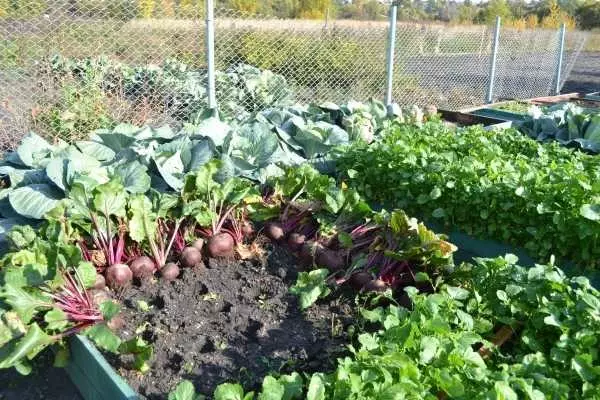
Vintage beets in high bed
High beds can be a good exit and in non-fermented lands. The delivered soil is more convenient to spread in beds, and not to distribute throughout the site. Maintaining fertility contributes to the compost layer, which is under the layer of land.
The problem of arid regions is solved. In this case, the fence for high beds from the inside is deceived by bitumen mastic or is covered with a film, stacked at the bottom (on the grid) rolled waterproofing material (rubreguld quickly rotates, so it's better something from modern type of hydroographs). Full waterproofing will not succeed, but keep moisture inside in sufficient quantity - yes.
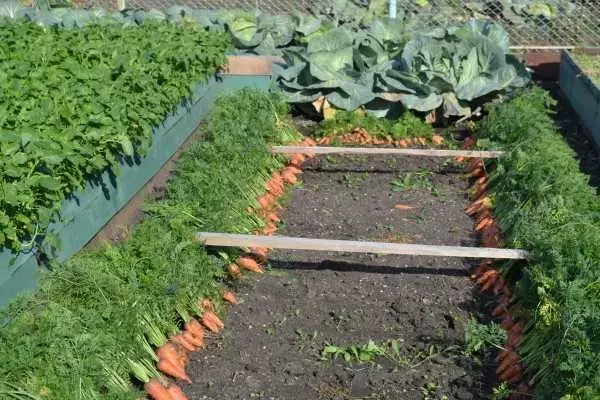
Carrot is one in one. The best in high bed, albeit on the usual Sadily the same grade
As you can see, with a suspended approach, you can solve almost any problem. The shortcomings of the high beds are a bit, but without them it did not cost:
- In most cases, it is necessary to make a fence, and these are costs.
- Labor consideration. Again, time for the manufacture of fence is required, and the decent volumes of land and plant residues are moved, and this is hard work.
- In the overoching leaves, branches, the cortex feel great, the bear feel and other similar living creatures. We have to lead the fight with them.
- Fertility has to support, updating or completely replacing the "filling".
That's all the flaws. If you decide to arrange high beds, be prepared for considerable work. But the crop will be many times more. For sample you can make one or two beds. And there decide, they need them or not.
Dimensions
There are no strict recommendations on this score, and can not: very different conditions in the country, and people too. There are sizes that many are considered optimal.
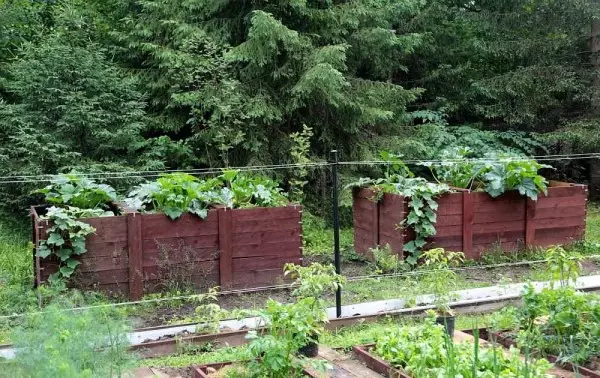
On one site, very high beds and not very ...
So, the size of high beds:
- Height - from 20 cm to 50-60 cm. Here you look at what is the difficult task. The higher the Ginochka raised, the easier it is to process it - less. But the lands and the rest of the "filling" will need more. Another point: if a small garden, the garden can be under the snow and will be covered with severe frosts, then high freezing through: also the sides are open. For those groes where annuals are sown, this is not playing with a nicely role, but for many years of strawberries, let's say this is a problem. Therefore, choose the height even on this considerations. According to the experience of many dacms for strawberries, the optimal height is 20 cm. Then you can hope that it will not get out.
- Width - from 60 cm to 1.2 m. Choose such a distance so that you can conveniently handle the garden. The distance 60-70 cm is chosen if the approach to the garden is only on the one hand. If you can get to it on both sides, you can make meter and more. It is important that the middle is processed without much voltage.
- Long. Here everyone chooses based on the configuration of the plot or their desire. The recommendations are not at all.
Article on the topic: Rod for curtains in the bathroom: Features of choice and installation
So that the garden is not too high, part of it can be burst: scramble at 20-30 cm, and on top of the walls. The shot of the soil will go on the back (the land is often not enough), and the substrate from the lower coarse layers can be thicker. And to minimize the cost of servicing such a bed, you can make a drip watering.
Than you can upset high beds
You can use everything that can keep the soil. The most durable borders are made of bricks, stone and concrete.
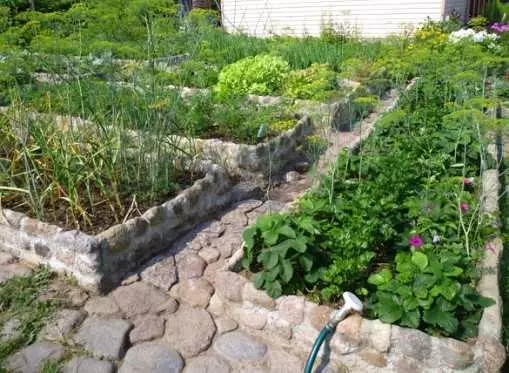
Beds from concrete and stone can be made and so
But the brick stands quite a few, with concrete a long time. The fence from the concrete is made in all the rules: first the formwork, which fit the reinforcement, then poured concrete and wait until he grab. But the service life is impressive - dozens of years.
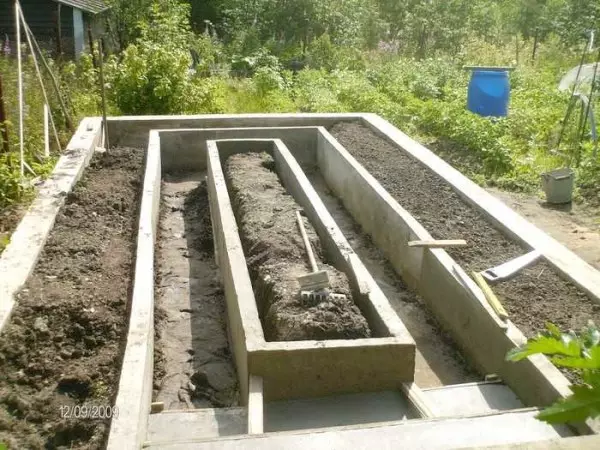
Fencing for beds from concrete the most durable and never "float"
The brick and stone fence also develops in all the rules: per solution with dressing. To reduce brick consumption, the walls are put into the pollipich. And so that the land does not move, the rows reinforce the grid.
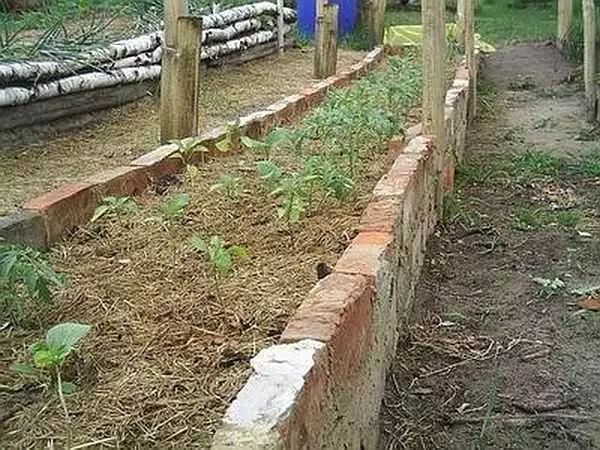
Brick masonry in Polkirpich itself can not hold the soil. Support pillars are needed
But even in this version, it will be necessary through the meter to install the reference pillars. If the ground is in your viscous, heavy, often overwhelmed, such walls can squeeze. Therefore, put wooden or metal supports that will fix long walls or make small beds, as for decorative vegetable garden.
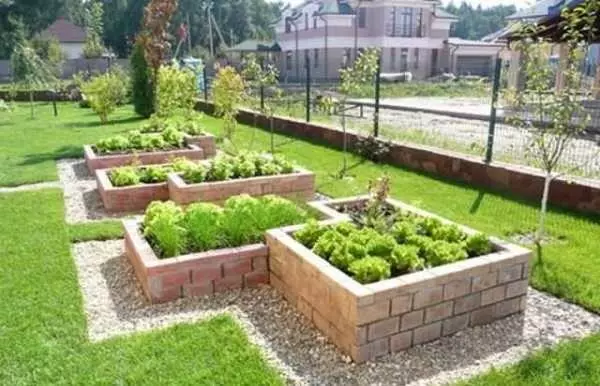
Brick high beds for decorative vegetable garden
Well-established fences from clay blocks. Even emptiness available in them can be filled with soil and there, too, plant plants with a small root system: for example, some types of greenery and salads.
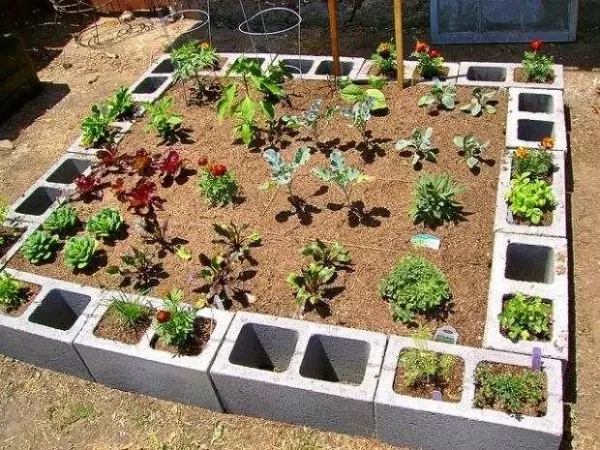
Fence for high beds from ceramzite concrete blocks
More fencing for high beds from galvanized metal and slate. Slate can be used by used, you can buy a new, wave or smooth - no difference. Sheets to cut into the bands of the required width. It is not harmful to fear. In slate, asbestos is contained in the associated state, and it does not dissolve with water. He is harmful when his saw: dust rises and through the airways falls into the body. To reduce harm, work in the respirator and also wet the place of the cut.
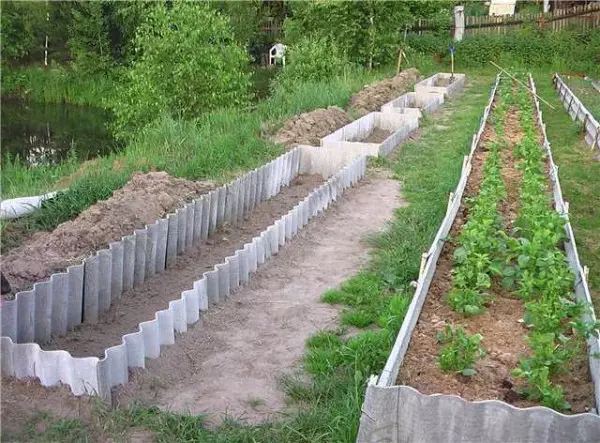
High beds from slate
Make fences for beds from plastic. Changed siding? Use it. There are old plastic panels - they are in business. But for plastic, a hard basis is needed. Make it from a metal grid of thick wire.
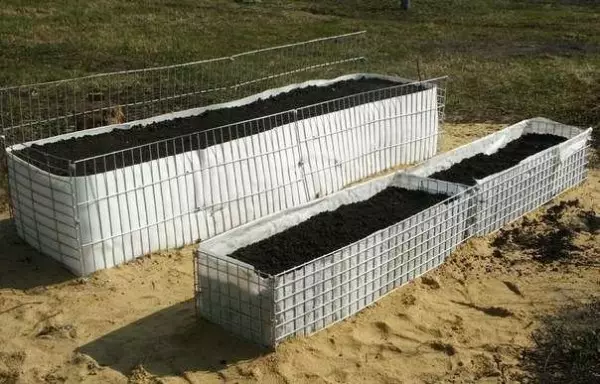
High beds in wire boxes
Grids can be the basis for pebbles or pellets. Only in this case will be needed a double frame, the inside of which stones or some material fall asleep. This technique is called "Gabion" and out of it are not only fences for the beds and flower, but also fences. But in order for water from the Gabion Grokes, the water does not flip through the walls, from the inside the box is lined with a dense film.
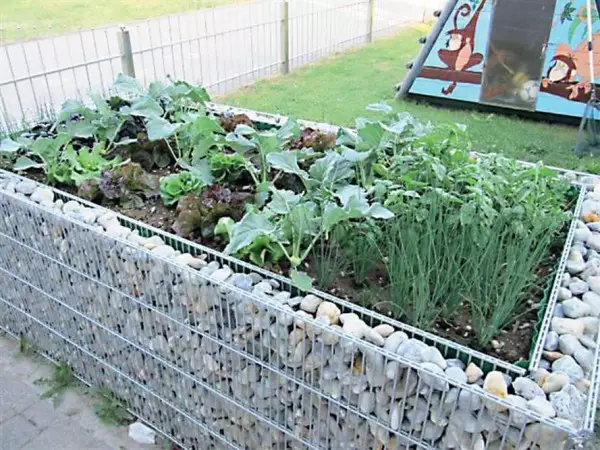
Fucking stone fence for high beds
The most popular fence is made of wood. You can use boards, timber, logs. Wood all good, except that she rotates.
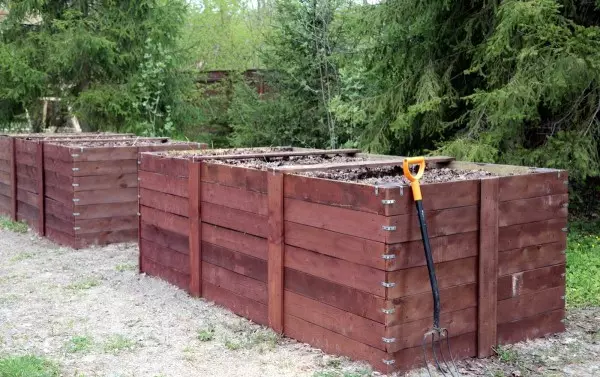
Really high garden
And since in high beds all conditions have been created to activate this process, then the destruction occurs quite quickly. Several slow down the process can paint the board or impregnating them with bioprotective composition. But the guarantees from destruction still do not.
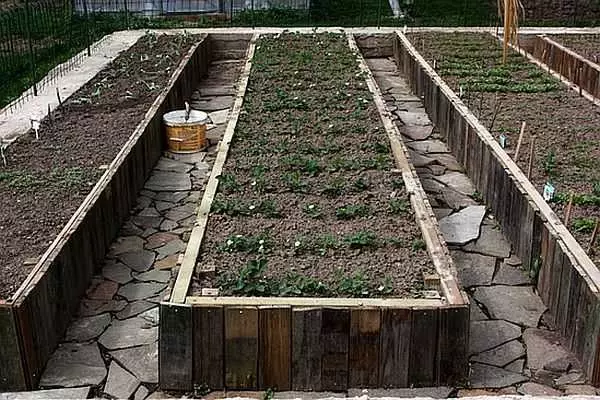
Cutting boards can also be used for high bedding
But the material can be used cheap, and sometimes, so in general, the removal: residues after construction, hill, old logs, pallets, etc. If you wish, you can make a fence even from branches. Only a bark is desirable to remove: it is under it there are many larvae and tremors. Although ... they will also recycle wood balances that you put on the bottom of the backfill. But too much their number is also not necessary, so, probably, it is still better to remove the bark.
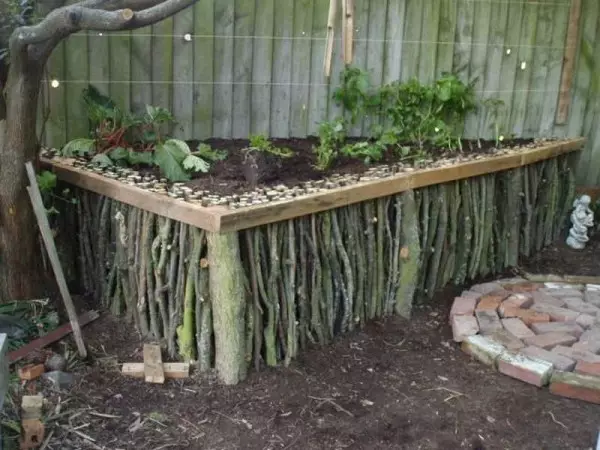
Even from branches you can make fencing
Of the same branches, only fresh cut, you can make a woven fence. And it will also be from the inside to be fastened with a film: to keep water and earth inside.
About how to make a plentine read here.
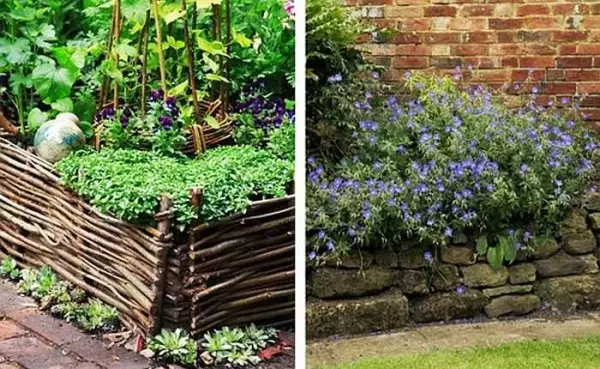
Framing for the beds can be soiled from fresh branches or lay out stones
Article on the topic: Interior of the bedroom in the style of Provence with their own hands (pictures, photos and videos)
You can use even straw. It is associated with small beams that connect with a wire with a wire. It can not be cheaper, and the water and the temperature holds well. The only minus of such an option is to drive such a fence to the maximum of two seasons, but rather - one. But it can then be used as one of the layers.
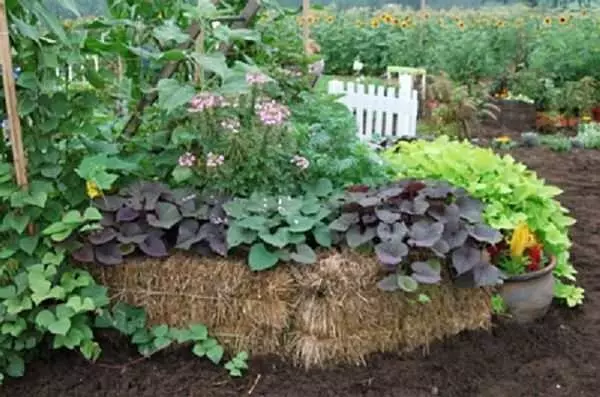
Straw Cutting Fencing
Funny beds
There are high beds without fence: the so-called bulk. The soil in them is poured in the form of hills.
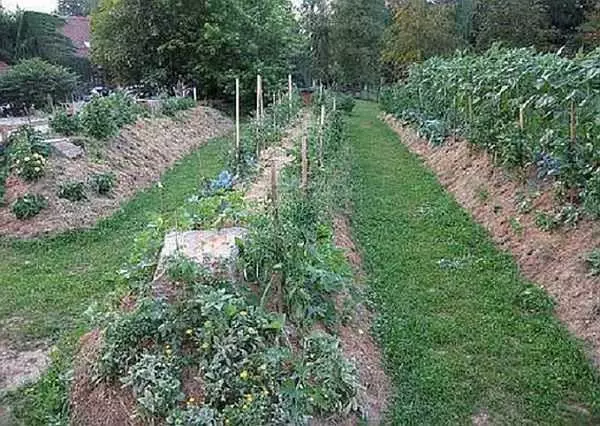
Funny beds
To improve drainage inside such ridges stacked branches. To reduce the height of the bed (for example, under tomatoes), it is a little deepen, folding the soil to the side. After laying the branches, it falls asleep on top, it often becomes necessary in additionally imported soil. If you can not choose a deep row.
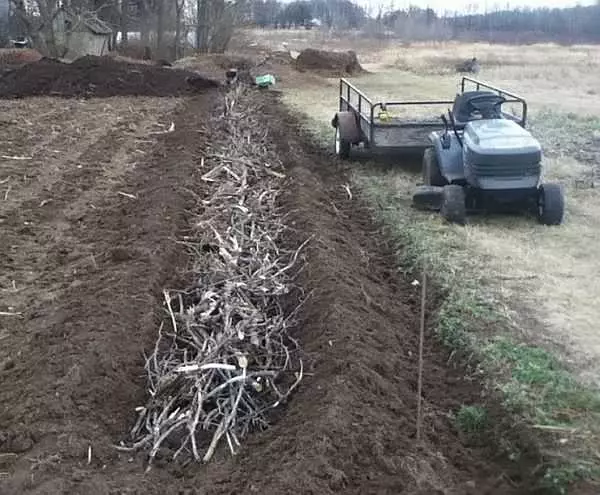
Internal device of bulk beds
The lack of this kind of garden: when watering and during the rains, the upper layer of the soil is washed off. Therefore began to make a box - to avoid leaching the soil.
Layers of high beds
Make a framing is just a small part of the work. You need another box to fill. Immediately, it must be said that the thickness of the layers depends on the height of the garden, which you have chosen, so that if some values are given, then exclusively approximately. In addition to the size of the bed to the thickness of the layer, for example, fertile, influences the choice of plants: there is enough 5 cm to someone, and someone needs much more.
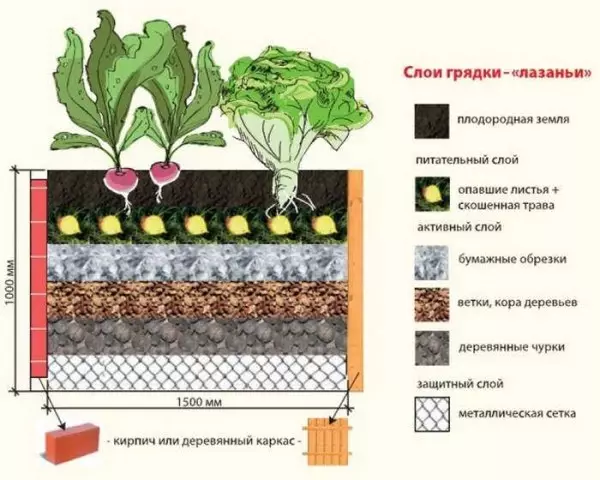
Sample layers for high bed
So, to pour into high beds - layers from below-up:
- A metal mesh with a shallow cell or a geotextile layer is placed on the bottom. You can lay cardboard. Mesh and geotextiles - protection against rodents and moles. Cardboard plays about the same role, but it is less effective.
- Large wood residues: thick branches, bunches, even chocks and bars. This layer serves first, for drainage, secondly, moisture accumulates in the wood. The more dry climate in your region, the more wood should be. Moreover, the following wood layers too.
- Ground small branches, bark. Other rude vegetable residues are suitable: stems of corn, straw. Their task is also double. They spare water, as well as decomposition, heat and nutritional elements are isolated. But when using corn trunks and straws, keep in mind that the garden will soon fall: these remnants are quickly rotated, but the yield will be high, and you can add a fertile land from above.
- Paper, thin cardboard. It is usually lined with a latter layer. More often use packing cardboard, because glossy paper does not fit, as well as newspapers: the lead paint base is not at all what the plants need to be fertilized. If there is an old unnecessary burlap (natural) you can lay it.
- Layer of plant residues: foliage, grass, semi-folded sawdust. With sawdust be careful: they are very sculpting the soil. So raw them under plants that love acidic soil, or neutralize acidity sprinkling them with a good layer of ash.
- Fertile land.
In the last two layers, you can add a good portion of the matured compost, as well as wake up their deeper layers. This will speed up the "readiness" of a high bed to landing.
About how to make a pond in the country, read here, and in this article it is written how to turn it into a fountain.
When it is better to do and that
Fill a high bed better with autumn. During this period, the "material" will be enough and during the winter processes are rotated. In this case, in the spring, you can plant plants and hope for a high harvest. It can also be made in the spring, but it is unlikely that there will be some significant differences in the yield: the processes will also begin and cannot have a noticeable effect on the fertility of the backfill. Although the difference in the amount of water for watering will notice exactly: water is required much less.
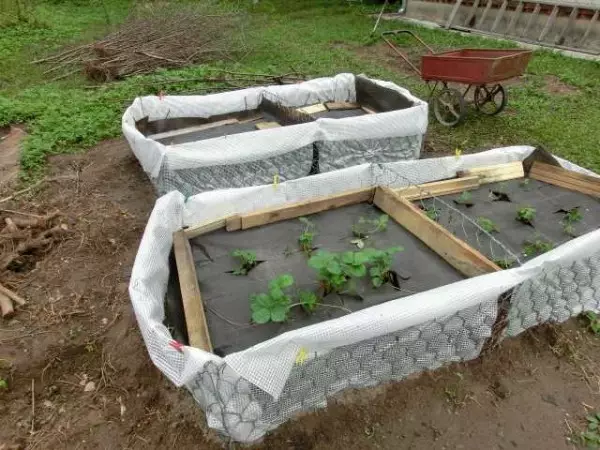
One of the variants of high beds: metal mesh and reinforced polyethylene film
Alternating plants
In the year of the device of a high bed on it, it is possible to plant plants requiring high fertility: cucumbers, zucchini, zucchini, pumpkin, any kind of cabbage, eggplant, tomatoes, sweet pepper. For another year, you can plant greens - spicy-aromatic and leafy. It feels well in the second year of the root.After collecting the second harvest, it is necessary to restore fertility. If the contents of the garden looked like, in the autumn, they sleep with a good ground mixed with a mature compost. If you have no one to hang out, part of the top layer is removed (on a compost bunch or other box as part of the backfill) and replace it with fresh land with fertilizers.
High beds for strawberry
It is only distinguished by the fact that over the finished "cake" spread the underfloor material. It makes holes in which plants are planted. This option leads to the fact that moisture evaporates in minimal quantities, and weeds are not growing in a heaters. The second option - the mulching of the Earth also works well, but evaporation is more intense.
Article on the topic: How to choose tulle with lambrene on the windows
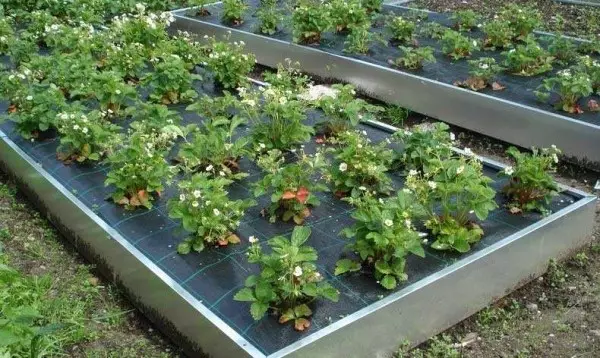
Strawberry feels good
The features of strawberries are that its roots are located mainly on the surface. Therefore, the fertile layer may be small. But the same feature leads to the fact that with severe frosts it can perish. At least inside a high bed and a decomposition process, heating the soil, if the garden will be without snow and not covered for the winter, can root system can freeze.
High beds for cucumbers and tomato
By your device, it is no different. Unless the fact that the edges of the poles and crossbars are needed or a stretched wire so that the bushes of tomatoes or the capes of cucumbers can be tied.
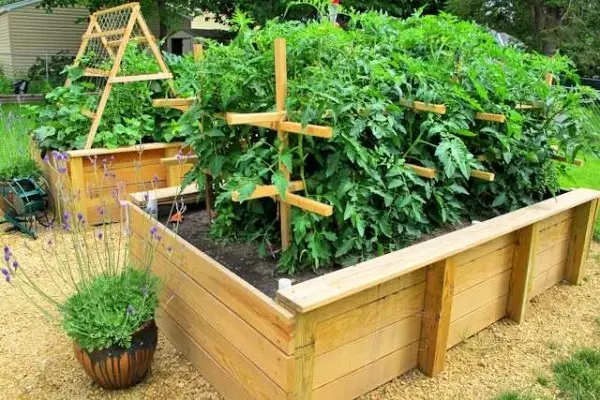
For cucumbers and tomato, you must take care of the garter
You can read about the organization of the auto oppoline of the garden or the site here.
High beds do it yourself
Most often questions arise not when laying the layers in high beds, but in the manufacture of a box. Since women are often born, women are engaged in the garden, right away for the manufacture of fences for beds, many moments may be incomprehensible. To clarify the most difficult, bringing a box manufacturing photo data from boards and slate - the most common fences.From the board
Several options for how to make high beds from the boards were in the photo above. The main snag is usually in conjunction in the corners. The easiest way to make their bangs: just put one to another at 90 ° and knock off the nails through. But there are aesthetes that everyone strive to do correctly. And correctly - to wash two boards at an angle of 45 ° and so to connect them. This is the option and will be demonstrated in the photo.
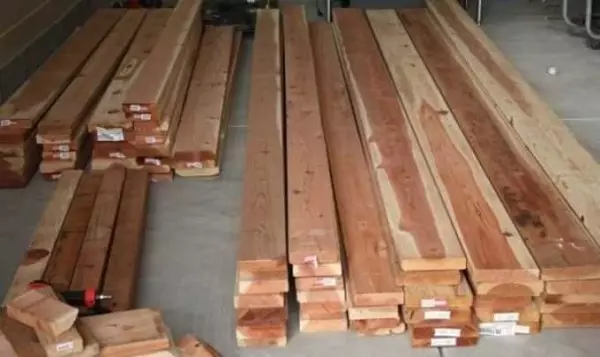
Strugated boards, processed impregnation for slowing down
To conveniently, the fence was fixed on the ground, with a step of 1.2-1.5 m, vertical bars or cuts of the board are nailed, the length of which is about 20 cm more than the selected garden height.
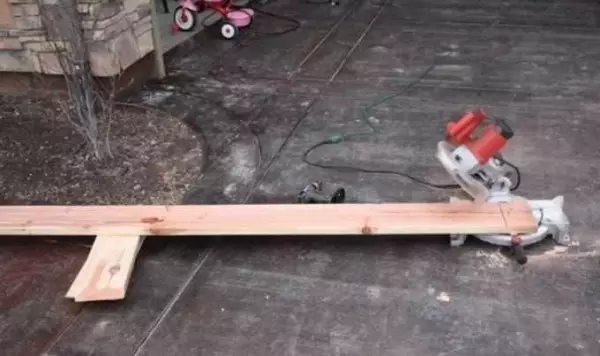
You feed the vertical bars so that the box was durable and it could be chopped
The bottom end of the bar or board needs to be sharpened - it will be easier to score the fence into the ground. Then we take a stouch or disk saw, and cut off the edge at an angle of 45 °. After folding two boards together we get the perfect angle of 90 °.
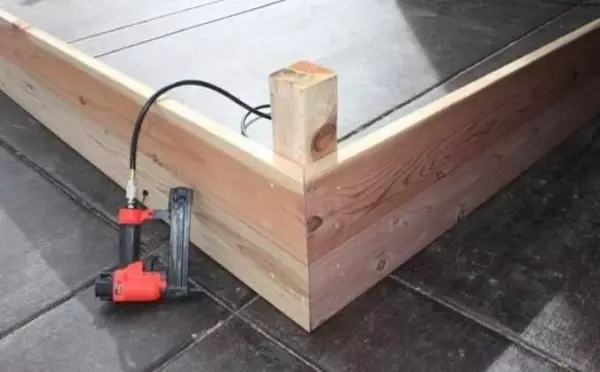
Properly made corner
For a durable connection from the inside of the angle, we set the bar to which you nail the boards.
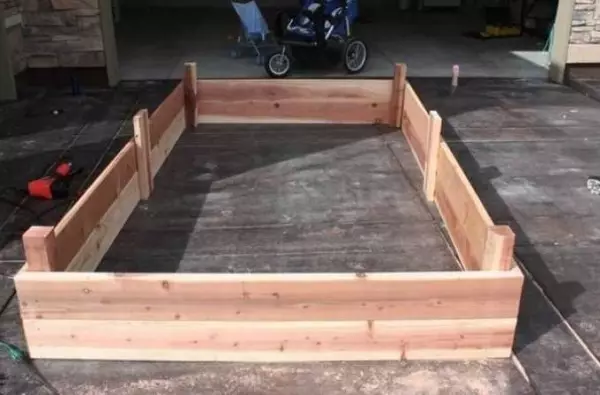
That's what happened. Only he is "noshami" up. They are clogged into the ground
Fencing for high beds made of wood for a short time, but even easier, to connect the online boards, and for the strength to nourish metal corners (in the photo below).
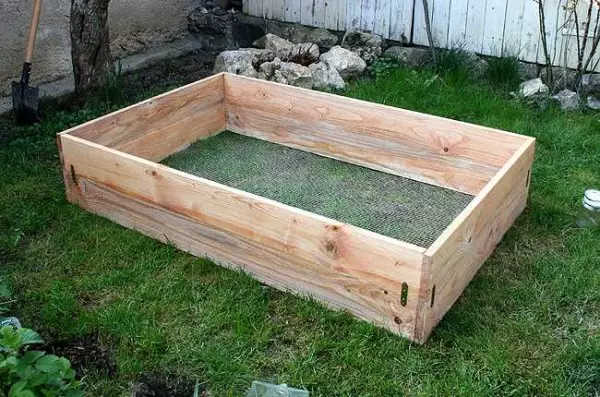
The easiest option
From Brenen.
It is no harder to make a similar box of supracted logs. For example, this option: two long sides of the logs, and short - from the segments of the boards.
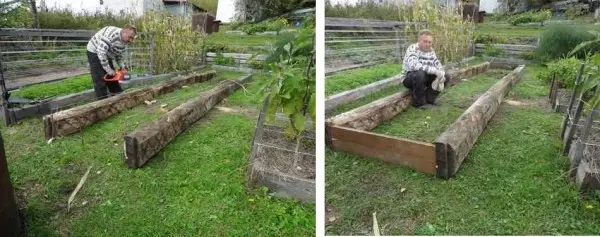
The advantage of logs is that they are heavy, and at the expense of their weight will be good to keep soil
Throwing a finished fence: and pest protection and a more attractive kind.
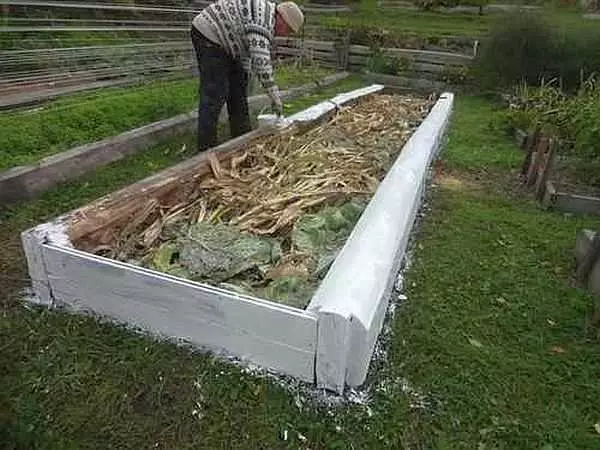
Getting Started
From slate
In the manufacture of beds from a flat or wave slate, questions also arise about how to fix it. The easiest way is to go. But it is not economically: you have to make a minimum of 10 cm to make stripes wider and still there is no guarantee that the spring slate will not "swim". In the risky earth, it will simply squeeze it. You can fix it, but this is too much time and effort.
Because most often with one or both sides of the sheet, the sheets are driven by corners or pipes, which clamp slate and do not give it strongly deviate. In the photo, the corners are driven only outside: from the inside there will be a mass of the layers of high beds, so that the fence is not falling inside.
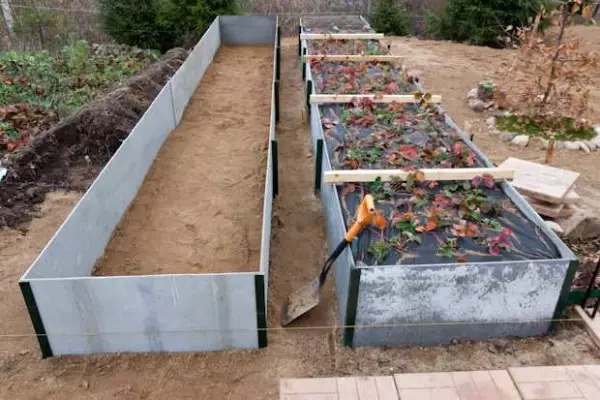
Fencing Grookok Slate
The connecting places of two sheets will be covered with a special welded plate. For reliability, they can be screwed to bolts to the wooden bar applied on the other side.
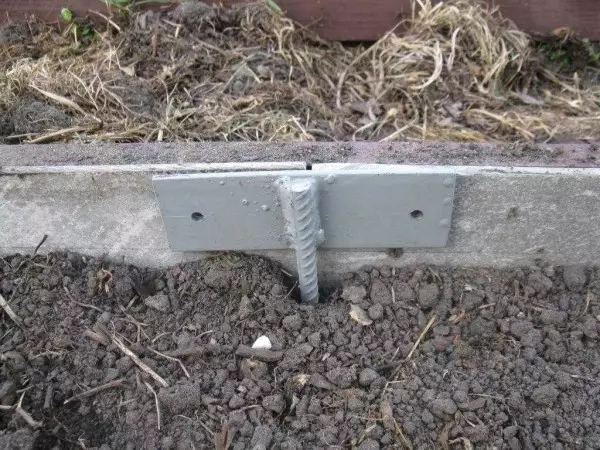
A piece of reinforcement with a welded plate - for the insuring of the joint of two sheets of flat slate
Another option is to make a frame. To similar racks with welded plates, attach a timber or corner - for whom what is cheaper. And it is fixed to this frame to the slate sliced on the band (nails in well holds, but easier with self-draws).
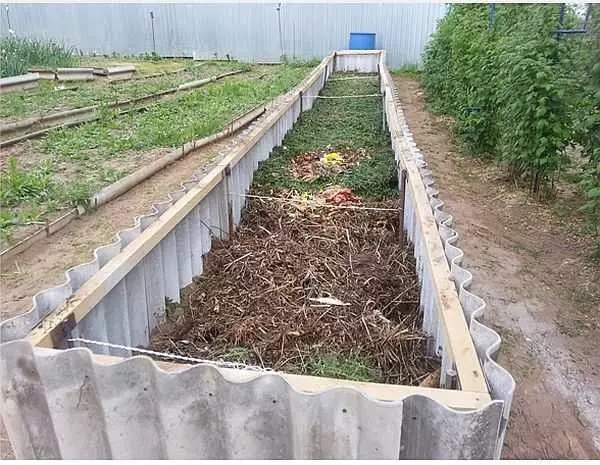
Frame from bar in a fence for high bed
By the same principle - with guides - make beds from plastic panels and other similar materials. As you understand, a particularly virtuoso skill here is not necessary. The main thing is to keep well.
